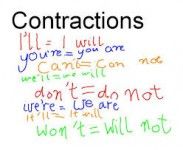contractions and punctuation
 When we talk about contractions and how they are shown in punctuation, we need first to understand the difference between abbreviations and contractions. Abbreviation and contractions of words – which we discussed in our section Rules and Usage: Contractions and Abbreviations – both serve to shorten a word, but while abbreviations omit the last few letters of the word, contractions omit letters in the middle of the word. Abbreviations and contractions have become even more common with the internet, texting, and the need to keep messaging and posting text to a minimum.
When we talk about contractions and how they are shown in punctuation, we need first to understand the difference between abbreviations and contractions. Abbreviation and contractions of words – which we discussed in our section Rules and Usage: Contractions and Abbreviations – both serve to shorten a word, but while abbreviations omit the last few letters of the word, contractions omit letters in the middle of the word. Abbreviations and contractions have become even more common with the internet, texting, and the need to keep messaging and posting text to a minimum.
When a word is abbreviated, there is a period at the end of the word to show that there are missing letters at the end of the word. If the sentence is exclamatory (ending with !) or interrogative (ending with ?) put these marks after the period.
“Did you send the package c.o.d.?”
contractions examples
When a word is contracted, the last letter of the word is still in place, and therefore no period, or full stop is used at the end of this word, e.g.:
Doctor Dr
Saint St
A contraction can also be an abbreviated form of more than one word. In contractions that represent more than one word, the letters that have been omitted should be replaced with an apostrophe:
She’ll She will
They’ve They have
Wouldn’t Would not
See our blog about contractions and apostrophes here.
Abbreviations and contractions of words both serve to shorten a word, but while abbreviations omit the last few letters of the word, contractions omit letters in the middle of the word



















